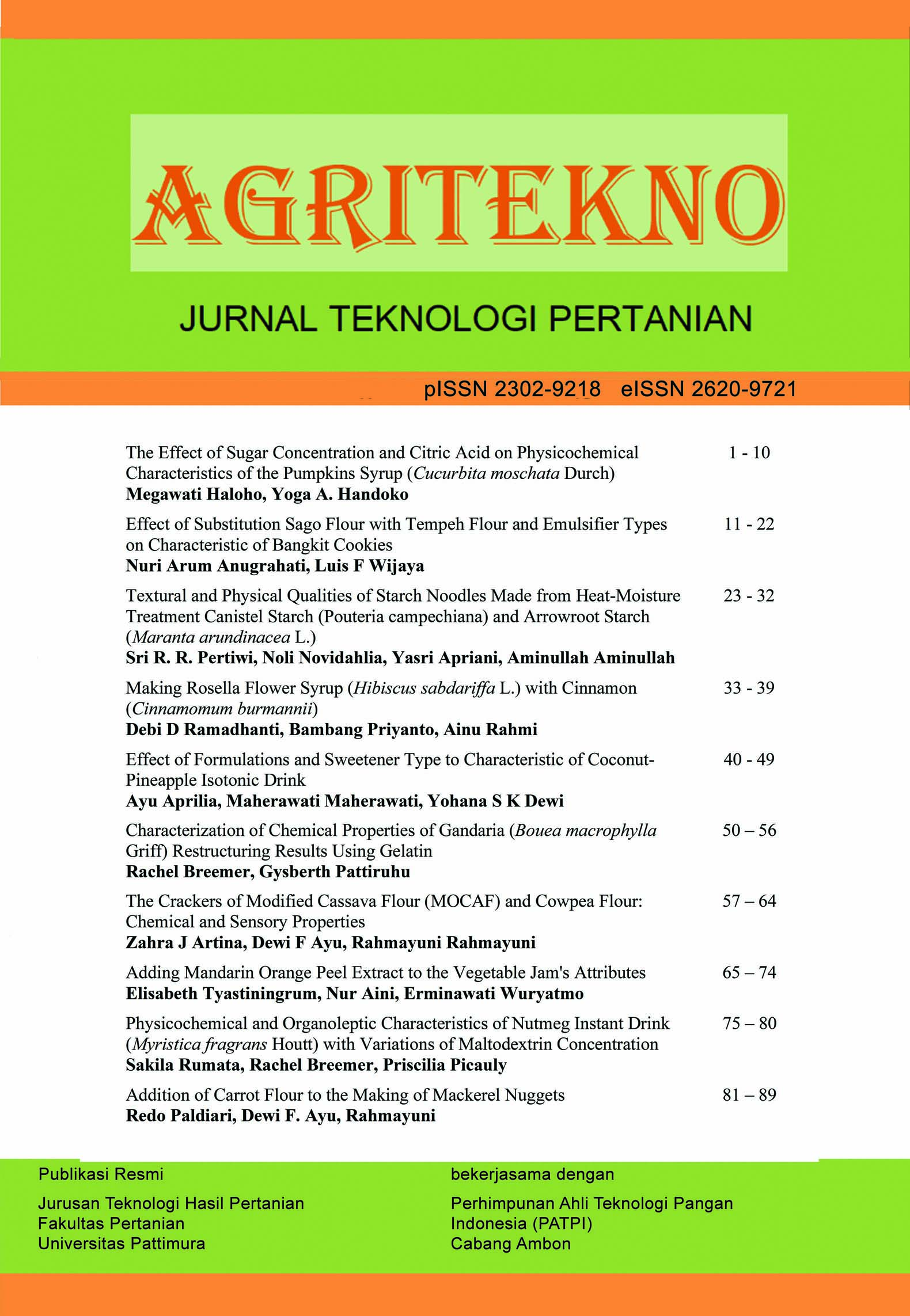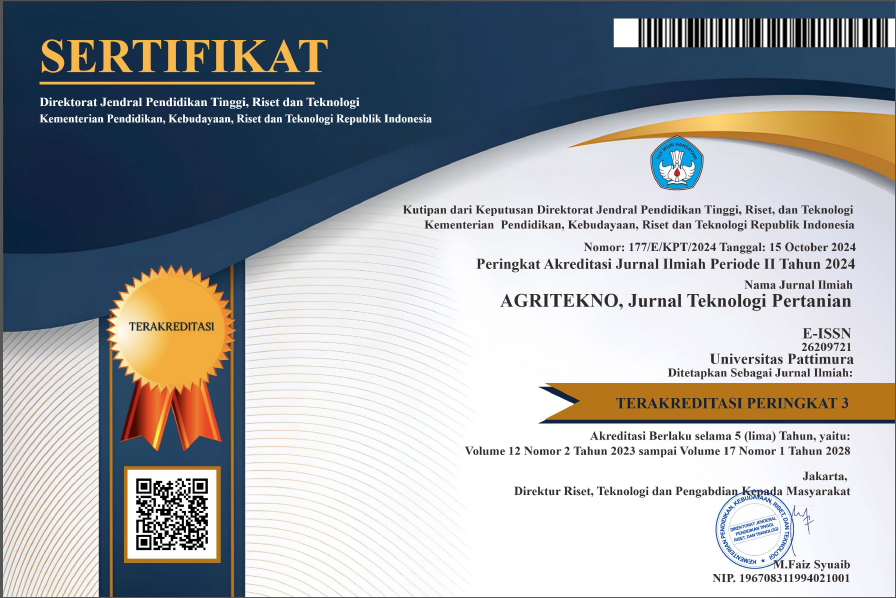Textural and Physical Qualities of Starch Noodles Made from Heat-Moisture Treatment Canistel Starch (Pouteria campechiana) and Arrowroot Starch (Maranta arundinacea L.)
Abstract
Glosor noodles were generally made from palm sago starch; in this study, glosor noodles were made from HMT (Heat-Moisture Treatment) modified canistel starch and arrowroot starch. This study aimed to investigate the effect of the ratio between canistel starch and arrowroot starch on the physical and textural qualities of glosor noodles and to determine the selected product of HMT-modified canistel starch and arrowroot starch. This study used the one-factor Completely Randomized Design method, consisting of five levels of canistel starch and arrowroot starch, i.e 100:0%, 90:10%, 80:20%, 70:30%, and 60:40%. The textural properties of hardness, gumminess, springiness, and elongation percentage, as well as the physical properties of cooking loss, water absorption, and swelling power, were analyzed. The results showed that the higher the addition of arrowroot starch, the lower the springiness, cooking loss, water absorption, and swelling index of glossy noodles; however, the higher the hardness, gumminess, and elongation percentage. The chosen glosor noodle was HMT-modified canistel and arrowroot starch with a ratio of 70:30%. It had a hardness of 3,600 N, a gumminess of 1.391 N, a springiness of 0.778 mm, and a percent elongation of 275.938%. In addition, it also had a cooking loss of 5.462%, a water absorption capacity of 130.095%, and a swelling index of 12.19%.
Downloads
References
Aminullah, Purba, R., Rohmayanti, T., & Pertiwi, S. R. R. (2020). Sifat mutu fisik mi basah berbahan baku tepung campolay masak penuh. Jurnal Agroindustri Halal, 6(2), 172–180. https://doi.org/10.30997/jah.v6i2.3168
Barak, S., Mudgil, D., & Khatkar, B. S. (2014). Effect of compositional variation of gluten proteins and rheological characteristics of wheat flour on the textural quality of white salted noodles. International Journal of Food Properties, 17(4), 731–740. https://doi.org/10.1080/10942912.2012.675611
Billina, A., Waluyo, S., & Suhandy, D. (2014). Kajian sifat fisik mie basah dengan penambahan rumput laut. Jurnal Teknik Pertanian Lampung, 4(2), 109–116.
Dessuara, C. F., Waluyo, S., & Novita, D. D. (2015). Pengaruh tepung tapioka sebagai bahan substitusi tepung terigu terhadap sifat fisik mie herbal basah. Jurnal Teknik Pertanian Lampung, 4(2), 81–90.
Ekafitri, R. (2010). Teknologi pengolahan mie jagung: Upaya menunjang ketahanan pangan indonesia. Pangan, 19(3), 283–293.
Engelen, A. (2017). Karakteristik kekerasan dan kelengketan pada pembuatan mi sagu basah. Journal of Agritech Science, 1(2), 64–67.
Faridah, D. N., Fardiaz, D., Andarwulan, N., & Sunarti, T. C. (2014). Karakteristik sifat fisikokimia pati garut (Maranta arundinaceae). Agritech, 34(1), 14–21.
Hartutik, S. (2019). Pengaruh Penambahan Tepung Bengkuang Termodifikasi dan Carboxymethyl Cellulose terhadap Sifat Fisik dan Tingkat Kesukaan Mi Basah. Universitas Mercu Buana Yogyakarta.
Herawati, D., Kusnandar, F., Sugiyono, Thahir, R., & Purwani, E. Y. (2010). Pati sagu termodifikasi HMT (Heat Moisture-Treatment) untuk peningkatan kualitas bihun sagu. Jurnal Penelitian Pascapanen Pertanian, 7(1), 7–15.
Husna, N. El, Lubis, Y. M., & Ismi, S. (2017). Sifat fisik dan sensory mie basah dari pati sagu dengan penambahan ekstrak daun kelor (Moringa oleifera). Jurnal Teknologi Industri & Hasil Pertanian, 22(2), 99–106.
Indrianti, N., Kumalasari, R., Ekafitri, R., & Darmajana, D. A. (2013). Pengaruh penggunaan pati ganyong, tapioka, dan mocaf sebagai bahan substitusi terhadap sifat fisik mie jagung instan. Agritech, 33(4), 391–398.
Kamsiati, E., Rahayu, E., & Herawati, H. (2021). Pengaruh konsentrasi binder dan lama waktu pengukusan terhadap karakteristik mi sorgum bebas gluten. Agrointek, 15(1), 134–145.
Kaur, L., Singh, J., & Singh, N. (2005). Effect of glycerol monostearate on the physico-chemical, thermal, rheological and noodle making properties of corn and potato starches. Food Hydrocolloids, 19(5), 839–849.
Li, P. H., Wang, C. W., Lu, W. C., Chan, Y. J., & Wang, C. C. R. (2022). Effect of resistant starch sources on the physical properties of dough and on the eating quality and glycemic index of salted noodles. Foods, 11(6), 1–12.
Maharani, K. (2018). Substitusi Tepung Umbi Garut (Maranta arundinacea L.) dan Tepung Tempe (Glycine Soya) dalam Pembuatan Mi Basah. Universitas Atma Jaya Yogyakarta.
Miftakhussolikhah, Ariani, D., Ervika, R. N. H., Angwar, M., Wardah, Karlina, L. L., & Pranoto, Y. (2016). Cooking characterization of arrowroot (Maranta arundinaceae) noodle in various arenga starch substitution. Berita Biologi, 15(2), 1–23.
Mojiono, M., Nurtama, B., & Budijanto, S. (2016). Pengembangan mi bebas gluten dengan teknologi ekstrusi development. Jurnal Pangan, 25(5), 125–136.
Oh, N. H., Seib, P. A., & Chung, D. S. (1985). Noodles III. Effect of processing variables on the quality characteristic of dry noodles. Cereal Chemistry, 62(6), 437–440.
Oktaviya, E. E., Muflihati, I., Affandi, A. R., & Umiyati, R. (2021). Karakteristik sensoris mi instan tersubstitusi tepung ganyong termodifikasi secara fisik. Jurnal Sains Terapan, 7(2), 42–51.
Pertiwi, S. R., Nurhalimah, S., & Aminullah, A. (2020). Optimization on process of ripe canistel (Pouteria campechiana) fruit flour based on several quality characteristics. Brazilian Journal of Food Technology, 23, 1–8.
Pertiwi, S. R. R., Aminullah, Rajani, R. U., & Novidahlia, N. (2022). Effect of heat-moisture treatment on the physicochemical properties of native canistel starch. Food Science and Technology (Brazil), 42(e103921), 1–10.
Polnaya, F. J., Haryadi, Marseno, D. W., & Cahyanto, M. N. (2012). Preparation and properties of sago starch phosphates. Sago Palm, 20, 3-11.
Setiyoko, A., Nugraeni, N., & Hartutik, S. (2018). Karakteristik mie basah dengan substitusi tepung bengkuang termodifikasi heat mositure treatment (HMT). Jurnal Teknologi Pertanian Andalas, 22(2), 102. https://doi.org/10.25077/jtpa.22.2.102-110.2018
Setyabudi, A. (2013). Pengembangan Mi Glosor Instan dari Tepung Sagu Aren dengan Substitusi Tepung Labu Kuning sebagai Alternatif untuk Diversifikasi Pangan. Institut Pertanian Bogor.
Sutrisno, E. T., Arief, D. Z., & Oktapiani, T. (2018). Karakteristik tepung campolay (Pouteria campechiana) untuk biskuit dengan variasi tingkat kematangan dan suhu blansing. Pasundan Food Technology Journal, 5(2), 111–121.
Taqi, F. M., Subarna, Muhandri, T., & Utomo, C. R. (2018). Efek penambahan propilen glikol alginat dan isolat protein kedelai terhadap mutu fisik dan mutu penerimaan mi jagung. Jurnal Teknologi dan Industri Pangan, 29(2), 201–209.
Wahyudi, M., & Kusningsih. (2008). Teknik pengeringan mi sagu dengan menggunakan pengering rak. Buletin Teknik Pertanian, 13(12), 62–64.
Wibowo, A. T. (2021). Karakteristik mi basah berbahan baku pati campolay (Pouteria campechiana) termodifikasi heat-moisture treatment dengan penambahan lesitin. Universitas Djuanda Bogor.
Widaningrum, Widowati, S., & Soekarto, S. T. (2005). Pengayaan tepung kedelai pada pembuatan mie basah dengan bahan baku tepung terigu yang disubtitusi tepung garut. Jurnal Pascapanen, 2(1), 41–48.
Copyright (c) 2023 The Author(s)

This work is licensed under a Creative Commons Attribution-ShareAlike 4.0 International License.
Authors who publish with this journal agree to the following terms:
- Authors retain copyright and grant the journal the right of first publication with the work simultaneously licensed under a Creative Commons Attribution License that allows others to share the work with an acknowledgement of the work's authorship and initial publication in this journal.
- Authors are able to enter into separate, additional contractual arrangements for the non-exclusive distribution of the journal's published version of the work (e.g., post it to an institutional repository or publish it in a book), with an acknowledgement of its initial publication in this journal.
- Authors are permitted and encouraged to post their work online (e.g., in institutional repositories or on their website) prior to and during the submission process, as it can lead to productive exchanges, as well as earlier and greater citation of published work (See The Effect of Open Access).









